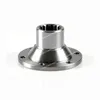In the world of mechanical and automotive engineering, components like Companion flanges play a crucial role in ensuring the smooth transmission of power and motion. A Companion flange is a type of coupling device used to connect rotating shafts, typically in drivetrain systems, providing a secure and reliable connection that handles high torque and misalignment.
Our Companion flanges are manufactured with precision and durability in mind, meeting international standards for quality and performance. Below, we dive into the detailed specifications, features, and common questions about these essential components.
Our Companion flanges come in a range of sizes and specifications to meet diverse application needs. Refer to the table below for detailed parameters.
| Model Number | Outer Diameter (mm) | Bolt Circle Diameter (mm) | Number of Bolts | Bolt Size | Weight (kg) | Application |
|---|---|---|---|---|---|---|
| CF-100 | 100 | 80 | 4 | M10 | 0.5 | Light automotive |
| CF-150 | 150 | 120 | 6 | M12 | 1.2 | Industrial machinery |
| CF-200 | 200 | 160 | 8 | M16 | 2.5 | Heavy-duty equipment |
| CF-250 | 250 | 200 | 8 | M20 | 4.0 | Agricultural implements |
What is a companion flange used for?
A companion flange is primarily used to connect two rotating shafts in mechanical systems, such as in vehicles or machinery, enabling torque transmission and accommodating slight misalignments.
How do I choose the right companion flange for my application?
Consider factors like shaft size, torque requirements, environmental conditions, and compatibility with existing components. Refer to our product table for specifications or consult with our technical team for guidance.
Can companion flanges be reused after removal?
Yes, if they are in good condition without significant wear, corrosion, or damage. However, always inspect for cracks or deformation before reinstallation to ensure safety and performance.
What maintenance is required for a companion flange?
Regular inspection for loose bolts, wear, and corrosion is recommended. Lubricate as per manufacturer guidelines and replace if any signs of failure are detected to prevent system breakdowns.
Are there different types of companion flanges based on material?
Absolutely. Common materials include carbon steel, stainless steel, and alloys, each offering varying levels of strength, corrosion resistance, and cost-effectiveness. Select based on your specific needs and operating environment.
How do I install a companion flange properly?
Ensure shafts are aligned, clean the mating surfaces, and tighten bolts to the specified torque using a crisscross pattern to distribute force evenly. Follow the manufacturer's instructions for best results.
What are the signs of a failing companion flange?
Symptoms include unusual noises (e.g., clunking or grinding), vibration, visible cracks or rust, and difficulty in transmitting power. Address these issues promptly to avoid further damage.
Can I customize a companion flange for unique applications?
Yes, we offer customization options for dimensions, materials, and bolt patterns. Provide your requirements, and our engineering team will assist in designing a solution tailored to your needs.


